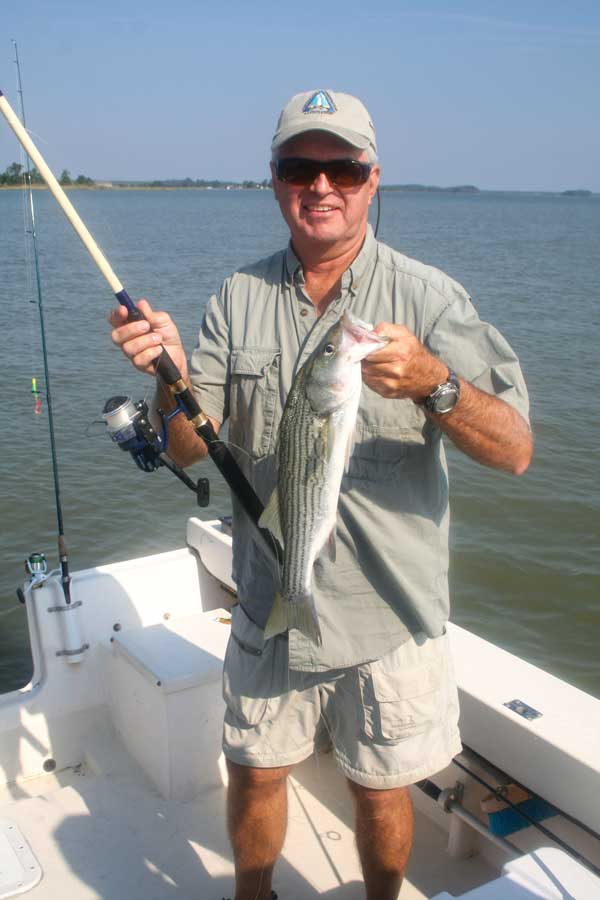Fall is the time to fish the marshes because this is when the bait fish and crabs move out to begin migrations to deeper water. Mullet are the best-known bait to make this move, but menhaden and all sorts of shellfish also start to migrate in the fall.

The shallow areas around Tangier Sound have seen good fishing for speckled trout all summer, so when fall comes around, those fish will be looking to stock up for the winter and will be gorging on all sorts of bait. Rockfish will do the same, especially the smaller ones that will remain in the Bay all winter.
Further down the Bay, the areas along the Eastern Shore will see the same action on speckled trout and rockfish. Hungers Creek is a well-known hot spot that I have fished with great success. On the Western Shore, locations near Gloucester also produce good speckled trout action.
In Delaware, the Lewes and Rehoboth Canal is fed by water from the Great Marsh with drains all along the banks. The Broadkill River is another good location for fishing once the mullet run begins.
The Seaside of the Eastern Shore of Virginia is nothing but marsh thanks to the work of the Nature Conservancy. Speckled trout and red drum are caught there all year with the best fishing in the fall.
One of my favorite spots is the mouth of Hungers and Mattawoman creeks where they meet the Chesapeake Bay. This is a shallow area with patches of grass where speckled trout like to hide. I didn’t have an electric trolling motor when I last fished there, but that would be a great addition and make for a stealth approach.
Without the electric trolling motor, we had to drift across the shallow water at the mercy of the wind and current, casting as we went. Once we recached deeper water, we started the outboard motor and ran slowly back along the deeper edge until we were upwind and current and could begin another drift.
About a mile south of there is a deep hole surrounded by very shallow sand bars that will hold speckled trout. The hole runs parallel to the shoreline, and here too you can drift the deep water, casting towards the sand bar, allowing the lure to fall as a bait might be washed over to the waiting trout.
This is small-boat, shallow-draft country. Also, boat ramps are at a premium. There was a very crude ramp at the top end of Hunger’s Creek, but I am not sure that’s there anymore. The closest good ramp is in Cape Charles. That’s a bit of a run to Hunger’s, but pretty close to the deep slough off of The Gulf.
In Maryland I have had good luck fishing the marsh out of Crisfield and Deal Island. Both locations have provided speckled trout and red drum with flounder caught alongside Smith Island.
From Deal Island we fished the marsh all along the edge of Little Deal Island and the Manokin River. I am sure all those drains had local names, but I don’t know what they are. We found rockfish and speckled trout in all of them.
The technique is pretty much the same no matter where you fish the marsh. Work the edges or over the grass beds with lures or baits.
When it comes to lures, the MirrOlure is by far the most popular. If you want to start a small war with a bunch of fanatics, state that such and such a color MirrOlure is the best. I have had good luck with the red head/white body while I have heard others tout the benefits of the electric chicken. The fact that the MirrOlure floats or is suspended makes it ideal for fishing over grass beds.
Paddletails are great for working deep drop-offs along the marsh edges where the water rushes past. Look for eddies behind any sort of structure where rockfish or trout can ambush bait.
Speaking of bait, nothing beats peeler or hard crab cut into pieces and either drifted with the current or fished on the bottom. Try casting an unweighted crab up into a drain on outgoing current and letting it wash back into the main creek or bay. If there is a trout or rockfish anywhere around, you will soon find out.
While live mullet are easy to catch in a cast net, they are difficult to keep alive. If you can keep them alive, try fishing one with a circle hook through the nose without weight.
By Eric Burnley